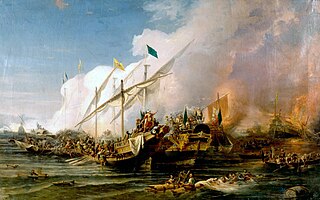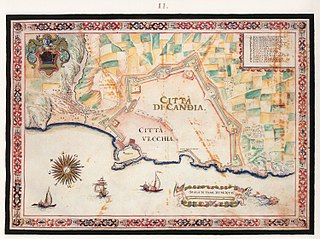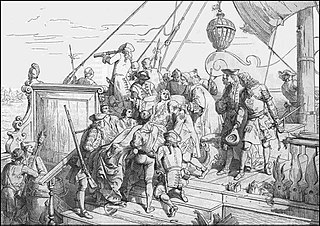The Holy League of 1717 was one of many coalitions organised by the Papal States to deal with the Ottoman threat. This last one comprised Portugal, the Republic of Venice and Malta.
The Holy League of 1717 was one of many coalitions organised by the Papal States to deal with the Ottoman threat. This last one comprised Portugal, the Republic of Venice and Malta.
Throughout the 16th and 17th centuries, several Holy Leagues were organized by the Papacy, the most famous of which finally managed to defeat the Ottoman fleet at the third Battle of Lepanto. However, the resurgent threat of the Ottoman fleet continued until the early 18th century and came again to the fore in the Seventh Ottoman–Venetian War of 1714–1718.
As with the previous Leagues, the Papal States organized the expedition, the Republic of Venice financed it and a third party - usually a Catholic kingdom - was to provide the support to the fleet. Given that Spain was exhausted from the War of the Spanish Succession, the Pope appealed to Portugal which ended up sending a fleet to the Mediterranean.
The efforts came to fruition in late July, when a combined fleet of Portuguese, Venetian, Papal, and Maltese ships engaged the fleet of Kapudan Pasha Eğribozlu İbrahim Pasha in the Battle of Matapan.
The outcome of 1717 as well as of the prior battles with the same goal, was that of restricting the Ottoman naval dominance to the eastern Mediterranean.
As a result of the battle, the Venetian attempt to recapture the Morea was foiled and the Ottoman reconquest of the peninsula was confirmed.

The Battle of Lepanto was a naval engagement that took place on 7 October 1571 when a fleet of the Holy League, a coalition of Catholic states arranged by Pope Pius V, inflicted a major defeat on the fleet of the Ottoman Empire in the Gulf of Patras. The Ottoman forces were sailing westward from their naval station in Lepanto when they met the fleet of the Holy League which was sailing east from Messina, Sicily.

The Battle of Preveza was a naval engagement that took place on 28 September 1538 near Preveza in the Ionian Sea in northwestern Greece between an Ottoman fleet and that of a Holy League. The battle was an Ottoman victory which occurred in the same area in the Ionian Sea as the Battle of Actium in 31 BC. It was one of the three largest sea battles that took place in the sixteenth century Mediterranean, along with the Battle of Djerba and the Battle of Lepanto.
Commencing in 1332 the numerous Holy Leagues were a new manifestation of the Crusading movement in the form of temporary alliances between interested Christian powers. Successful campaigns included the capture of Smyrna in 1344, at the Battle of Lepanto in 1571 and the recovery of some parts of the Balkans between 1684 and 1697.

The Holy League of 1571 was arranged by Pope Pius V and included the major Catholic powers of southern Europe, specifically the Spanish Empire as well as the Italian maritime powers. It was intended to break the Ottoman Empire’s control of the eastern Mediterranean Sea and was formally concluded on 25 May 1571.

A series of military conflicts between the Ottoman Empire and various European states took place from the Late Middle Ages up through the early 20th century. The earliest conflicts began during the Byzantine–Ottoman wars, waged in Anatolia in the late 13th century before entering Europe in the mid-14th century with the Bulgarian–Ottoman wars. The mid-15th century saw the Serbian–Ottoman wars and the Albanian-Ottoman wars. Much of this period was characterized by the Ottoman expansion into the Balkans. The Ottoman Empire made further inroads into Central Europe in the 15th and 16th centuries, culminating in the peak of Ottoman territorial claims in Europe.

The Great Turkish War, also called the Wars of the Holy League, was a series of conflicts between the Ottoman Empire and the Holy League consisting of the Holy Roman Empire, Poland-Lithuania, Venice, Russia, and the Kingdom of Hungary. Intensive fighting began in 1683 and ended with the signing of the Treaty of Karlowitz in 1699. The war was a defeat for the Ottoman Empire, which for the first time lost substantial territory, in Hungary and the Polish–Lithuanian Commonwealth, as well as in part of the western Balkans. The war was significant also for being the first instance of Russia joining an alliance with Western Europe.

The siege of Candia was a military conflict in which Ottoman forces besieged the Venetian-ruled capital city of the Kingdom of Candia. Lasting from 1648 to 1669, or a total of 21 years, it is the second-longest siege in history after the siege of Ceuta. It ended with an Ottoman victory, but the effort and cost of the siege contributed to the decline of the Ottoman Empire, especially after the Great Turkish War.

The Battle of Matapan, also known as the Battle of Cape Matapan, took place on 19 July 1717 off the Cape Matapan, on the coast of the Mani Peninsula, now in southern Greece. The naval battle was between the Armada Grossa of the Republic of Venice, supported by a mixed squadron of allied ships from Portugal, the Papal States and Malta, and the Ottoman fleet, under Kapudan Pasha Eğribozli Ibrahim Pasha.

Cape Matapan, also called Cape Tainaron or Taenarum, or Cape Tenaro, is situated at the end of the Mani Peninsula, Greece. Cape Matapan is the southernmost point of mainland Greece, and the second southernmost point in mainland Europe. It separates the Messenian Gulf in the west from the Laconian Gulf in the east.

The Battle of Djerba took place in May 1560 near the island of Djerba, Tunisia. The Ottomans under Piyale Pasha's command overwhelmed a large joint Christian alliance fleet, composed chiefly of Spanish, Papal, Genoese, Maltese, and Neapolitan forces. The allies lost 27 galleys and some smaller vessels as well as the fortified island of Djerba. This victory marked perhaps the high point of Ottoman power in the Mediterranean Sea.

Piali Pasha was an Ottoman Grand Admiral between 1553 and 1567, and a Vizier (minister) after 1568. He is also known as Piale Pasha in English.

The Ottoman Navy or The Imperial Navy, also known as the Ottoman Fleet, was the naval warfare arm of the Ottoman Empire. It was established after the Ottomans first reached the sea in 1323 by capturing Praenetos, the site of the first Ottoman naval shipyard and the nucleus of the future navy.
The Holy League of 1538 was a short-lived alliance of Christian states arranged by Pope Paul III at the urging of the Republic of Venice.
Salah Rais was the 7th King of Algiers, an Ottoman privateer and admiral. He is alternatively referred to as Sala Reis, Salih Rais, Salek Rais and Cale Arraez in several European sources, particularly in Spain, France and Italy.

The Seventh Ottoman–Venetian War was fought between the Republic of Venice and the Ottoman Empire between 1714 and 1718. It was the last conflict between the two powers, and ended with an Ottoman victory and the loss of Venice's major possession in the Greek peninsula, the Peloponnese (Morea). Venice was saved from a greater defeat by the intervention of Austria in 1716. The Austrian victories led to the signing of the Treaty of Passarowitz in 1718, which ended the war.

The Cretan War, also known as the War of Candia or the Fifth Ottoman–Venetian War, was a conflict between the Republic of Venice and her allies against the Ottoman Empire and the Barbary States, because it was largely fought over the island of Crete, Venice's largest and richest overseas possession. The war lasted from 1645 to 1669 and was fought in Crete, especially in the city of Candia, and in numerous naval engagements and raids around the Aegean Sea, with Dalmatia providing a secondary theater of operations.

The Fourth Ottoman–Venetian War, also known as the War of Cyprus was fought between 1570 and 1573. It was waged between the Ottoman Empire and the Republic of Venice, the latter joined by the Holy League, a coalition of Christian states formed by the pope which included Spain, the Republic of Genoa, the Duchy of Savoy, the Knights Hospitaller, and the Grand Duchy of Tuscany.

The siege of Corfu took place on 8 July – 21 August 1716, when the Ottoman Empire besieged the city of Corfu, on the namesake island, then held by the Republic of Venice. The siege was part of the Seventh Ottoman–Venetian War, and, coming in the aftermath of the lightning conquest of the Morea by the Ottoman forces in the previous year, was a major success for Venice, representing its last major military success and allowing it to preserve its rule over the Ionian Islands.

The Genoese navy was the naval contingent of the Republic of Genoa's military. From the 11th century onward the Genoese navy protected the interests of the republic and projected its power throughout the Mediterranean and Black Seas. It played a crucial role in the history of the republic as a thalassocracy and a maritime trading power.

Lodovico Flangini was a Venetian noble who served as Capitano Straordinario delle Navi during the Seventh Ottoman–Venetian War.